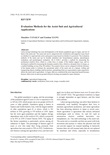Evaluation Methods for the Assist Suit and Agricultural Applications
Japan Agricultural Research Quarterly
| ISSN | 00213551 |
|---|---|
| NII recode ID (NCID) | AA0068709X |

Full text
jarq59-2_101-118.pdf1.58 MB
Labor-saving technology has seen developments as the farmer population ages in Japan, and one of them is the assist suit. The assist suit can be categorized into exoskeleton and supporter types based on whether it is rigid and into active and passive types based on whether it is powered. The evaluation methods of the assist suit can be broadly classified into biomechanical analysis, physiological evaluation, and psychological evaluation. JIS B 8456-1 provides a method for measuring the mechanical assistive force, which is a static force or torque, of the lumbar support type, and we developed a method for measuring the dynamic assistive force, which is a dynamic force or torque, as a method building on top of the JIS method. The assistive forces can be compared with the tolerance of the human joints to estimate the operational safety of the assist suit on a human. Lifting and transporting objects, holding a half-sit posture, and picking fruits are representative tasks expected to utilize the assist suit in agriculture. In Japan, falls are considered the most important hazard because farmers often work on uneven ground with poor footing surrounded by many obstacles.
| Date of issued | |
|---|---|
| Creator | Masahiro TANAKA Xiaohan XIANG |
| Subject | exoskeleton farm work torque wearable robot |
| Publisher | Japan International Research Center for Agricultural Sciences |
| Received Date | 2024-01-11 |
| Accepted Date | 2024-06-26 |
| Available Online | |
| Volume | 59 |
| Issue | 2 |
| spage | 101 |
| epage | 118 |
| DOI | 10.6090/jarq.23S20 |
| Language | eng |
